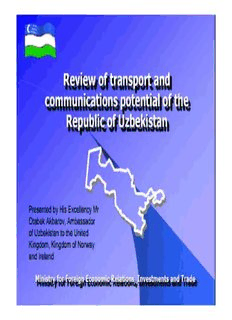
Presented by His Excellency Mr Otabek Akbarov, Ambassador of PDF
Preview Presented by His Excellency Mr Otabek Akbarov, Ambassador of
Presented by His Excellency Mr Otabek Akbarov, Ambassador of Uzbekistan to the United Kingdom, Kingdom of Norway and Ireland Introduction Since gaining independence in 1991, Uzbekistan, through the implementation of a package of fundamental measures, has ensured consistent economic growth. Uzbekistan is the leading industrial centre within the Central Asia region with the most developed transport infrastructure network in the region. Pursuing an active investment and modernisation policy, Uzbekistan has established new high-tech industries Automobile industry – gas chemistry- engineering – oil and gas – railway engineering – pharmaceuticals - and others. Despite the global financial and economic crisis, for the last 3 years GDP growth was above 8%. This has been achieved through rapid development of transport and communications and diversification of international transport corridors. International Transport Corridors The main directions of the Uzbekistan’s transport policy are: • integration into international transport communications; • development of effective international foreign trade and transit goods transportation routes; and • modernisation of the transport sector and increase of transit capacity. Our major international transport corridors are directed to: • Ports of the Baltic States; • Ukrainian ports with access to the Black Sea; • Georgian ports along the TRACECA Corridor; • Russian Far Eastern ports; • Iranian ports with access to the Gulf; • Belarus and Ukraine towards European countries; and • China. Development of Railways In recent years projects have been gradually implemented in construction of new railways with length of almost 350 miles (Navoi-Uchkuduk-Nukus (212 miles) and Toshguzar-Baysun-Kumkurgan (137 miles)). More than 373 miles of railway lines were reconstructed 12 freight locomotives and 15 passenger locomotives were purchased and railway line from Tukimachi to Angren (89 miles) was electrified. Development of Railways (cont.) In recent years a programme of new railway line construction and existing line and rolling stock upgrades has been implemented. This includes: • 350 miles of new railway lines • 150 miles of existing line upgrades • Purchase of 12 freight locomotives and 15 passenger trains In 2013 it is envisaged that approximately 288 million USD will be invested in the development and modernisation of the railways. This will include the construction of 116 miles double-track electrified railway line Jizzak-Yangiyer (Phase 1). Other projects include the Electrification of the Karshi-Termez and Marokand- Karshi railway lies. Development of Railways (cont.) In 2011 Spanish high-speed passenger trains Talgo-250 were commissioned between the major cities of Uzbekistan, with speed in some areas up to 155 m/h. In addition, Uzbekistan plans to build by 2016 a new electrified railway line, Angren-Pap. Uzbekistan Railways estimates the cost of the construction, which will connect the Ferghana Valley with the rest of Uzbekistan through Kamchik Pass, at 1.9 billion USD. The development of a final version of a feasibility study of the project is to be completed by the end of 2013, and in early 2014 the construction will begin. The project involves construction of two tunnels.
Description: